|
 |
|
|
|
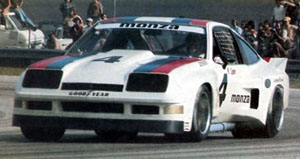
Al Unser drives
DeKon 1003 for DeKon Engineering, LTD at IMSA Daytona Finale
on Nov. 30, 1975. Michael Keyser would become next owner.
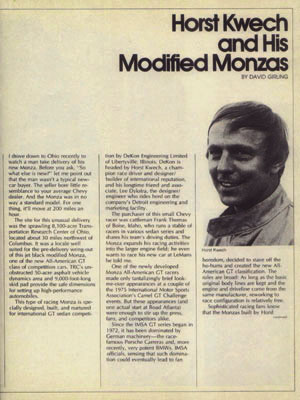
The Man who beat Porsche

Chart
of Monza Chassis Numbers
More Monza Photos by RacingSportsCars |

|
DeKon was the most successful and recognized builder
of the H07 silhouette Monza GT racecars. The DeKon
modified Chevrolet Monza won
the IMSA GT championships in 1976, 1977 and
1978.
In 1974,
Chevrolet assisted DeKon Engineering in the design
and development of the tube frame Monza race car.
General Motors' first automotive design venture
using computer aided design and drafting (CADD) was
with the Chevrolet Monza. Around late 1974, DeKon
began receiving Monza production chassis from GM in
order to make the radical transformations from
street to track car.
GM built the H07 body Monza from 1975-80, and it has
enjoyed a great run of success in road racing and
many other forms of auto racing. The Chevrolet Monza
was almost exclusively used as the base to build
these racecars. A Pontiac Astre and Buick Skyhawk
were also built for racing.
DeKon Engineering, LTD was formed in July 1974 by
Lee Dykstra and Horst Kwech; the most successful and
recognized of all the H07 racecar builders. The name
DeKon is a concatenation of the D in Dykstra and the
K in Kwech. It is also short for Design and
Construction. DeKon was located in Libertyville,
Illinois. In three years, they produced seventeen
racecars. Of these, fourteen were Monzas.
The cars were designed by Horst Kwech of Ausca
Racing and Lee Dykstra and used to combat the highly
successful Porsches in IMSA (International Motor
Sports Association) competition. General Motors
aided in the project with CAD drawings, their first
attempt at using this technology. Chevrolet had a
great deal to do with the design of the DeKon
chassis. Design/construction was Kwech's group who
actually built the DeKon Monzas and sold them to
customers.
GM started producing Monzas near
the close of 1974 and DeKon received them as
complete cars. They would tear down and reconstruct
them to the needs and specifications of their
customer's.
The Dekon Monza featured a
tubular frame chassis, an overall weight of about
2,400 pounds, and over 600 horsepower from a
fuel-injected V-8 engine. The cars were very fast
and competitive, thanks in part to their excellent
50/50 weight distribution.
Engines used were
heavily modified Chevrolet 5.7-6.0 L V8
small-blocks, normally aspirated, some using four
Weber (2V) downdraft carburetion. They developed as
much as 650 horsepower. The car's lightweight, high
horsepower combination was a formidable competitor
in IMSA and other racing series. After some teething
problems the DeKon Monza of Al Holbert won the IMSA
GT Championship in 1976 and 1977.
These cars mostly ran in IMSA's Camel GT Challenge
Series in the All-American Grand Touring (AAGT)
class from 1975-1986. Also in the SCCA Trans-Am pro
series and its club racing amateur events.
DeKon Monzas were built from 1975 to about 1978.
Even today, H07s can be seen racing and winning.
Price tag for a new DeKon Monza was around $38,000,
race ready. Vintage racing is the main attraction
for restored road racing Monzas, but there are a few
still slugging it out in SCCA and NASA race groups.
A fully restored Monza can fetch as much as
$268,000, about seven times the original build
price. Not all DeKon Monzas have a chassis
identification plate. Horst Kwech has been
granted 17 patents and is an active design engineer
today. |
|
|
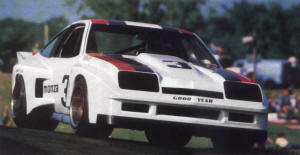
Horst Kwech DeKon 1005 giving it a
shakedown at Mid-America in July 1975. Allan Moffat
took ownership five months later.
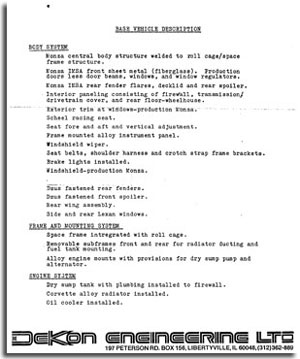
Monza build description by DeKon
Engineering, Ltd.
|
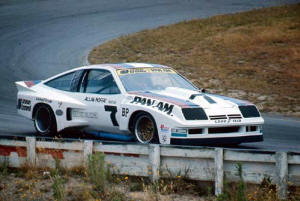
Allan Moffat driving his DeKon c/n 1005 at Bay Park
Raceway, New Zealand - December 28, 1975. |
|
In a February 1976 interview Moffat remarked,
“Last November [1975], at Daytona, I reached the highest
speed I have ever made on a race track - 204 mph, in this
very same Monza I have now. I had gone to the US at the
invitation of my old pal, Horst Kwech, who is actually an
expatriate Australian …” |
|
|
|
DeKon Chassis Numbers and Owners
From: World Sports Racing
Prototypes |
|
1001 |
The first IMSA AA/GT Monza was fielded
by DeKon Engineering, LTD and driven by
Horst Kwech. White with red pinstripe.
Made it's debut at Road Atlanta on April
20, 1975 but crashed. Rebuilt and sold
to Maurice Carter who briefly raced in
IMSA. It's influential impact on IMSA
AA/GT racing design is still seen on
today's racecars. |
|
1002 |
Harry Theodoracopulos IMSA AA/GT
Monza. Metallic blue. It debuted at
Lime Rock on May 26, 1975 and also
crashed. Rebuilt and resumed racing
with the same owner. |
|
1003 |
Driven by Al Unser for DeKon
Engineering. White with red/blue
stripes on roof. Became Michael
Keyser's for 1976 IMSA, scoring 3
victories. Converted to DeKon phase
5 body for Brad Frisselle and 1977
IMSA rules and entered in 24 Hours
of Le Mans in 1978. Wynn's
sponsored, white, orange, yellow and
blue colors. Preserved in
Frisselle form for Historic
Sportscar Racing as of 2010. |
|
1004 |
Tom Franks IMSA and SCCA T/A CAT.II
Monza 1977-78. White with green
accents. DeKon phase 4 body updated
to phase 5. Car is fully restored to
original form. |
|
1005 |
Alan Moffat's 1976-77 Australian GT
Championship Monza. DeKon phase 3
body. White with red/blue stripes.
Car is now in the US and pending
restoration. |
|
1006 |
Michael Keyser's 1976-77 IMSA Monza.
White with red/blue stripes. It was
outfitted with a Lola Can-Am rear
wing. DeKon phase 4 body. Ran the 24
Hours of Le Mans in 1976. Roy
Woods painted yellow and converted
to a twin-turbo V8 for IMSA and SCCA
T/A CAT.II from 1977-81. Currently
under restoration in the US. |
|
1007 |
Jerry Jolly's IMSA and T/A CAT.II
Monza. Orange with blue/yellow
pinstripes. DeKon phase 3 body.
Restored and currently campaigned in
vintage racing by Steve Walker on
the west coast. |
|
1008 |
Al Holbert's 1976 effort, scored 7
victories and won the 1976 IMSA
AA/GT championship. Phase 3
body style, blue and yellow with red
accents. Scored first IMSA win for
Monza at Road Atlanta in '76. Bought
by John Paul and competed in 1977
IMSA races. Painted light blue w/
yellow stripes and updated to phase
5 body. Purchased by Floridian Joe
Gonzalez and campaigned in IMSA GTO
throughout 1980's. Sold to private
collector in New York. |
|
1009 |
A
Camaro built for circle-track
racing. |
|
1010 |
Greg Picket's '77 effort, mostly for
Trans-Am (Cat.II) and IMSA GT. White
with yellow and red diagonal paint
scheme. DeKon Phase 4 body with rear
banana wing. |
|
1011 |
Chris Cord's '77-81 IMSA racecar.
Painted red and ran as car no. 19..
DeKon phase 5 body and wing. Had the
most radical bodywork seen on a
Monza in 1980-81. Last of the "TRUE"
IMSA AA/GT Monzas. Present ownership
undisclosed. |
|
1012 |
Originally built for Ted Fields'
Interscope Racing team, raced twice
by Danny Ongais. Became Second car
for Chris Cord Racing driven by Jim
Adams for IMSA 1980-81. Livery
similar to DeKon 1011, red no. 20
with Budweiser sponsorship. Rebuilt
as a GTP attempt in the early 1980's
by CCR. Donated to museum in
Las Vegas and sat for many years.
Purchased by Ken Epsman in 2005.
Restored to IMSA AA/GT for vintage.
|
|
1013 |
Never
completed. "Bad luck," according to
Horst Kwech. |
|
1014 |
Al Holbert's 1977 effort. Won the
1977 IMSA AA/GT championship,
including four victories. Phase 5
body with same blue with yellow and
red accents as DeKon 1008. David
Heinz bought it for selected IMSA
races in 1978-79. Painted red and
white with Budweiser sponsorship.
Sold in 1979 to South American team.
May have been privately raced in
IMSA GTO. Currently in private
collection in New York. |
|
1015* |
DeKon's only Buick Skyhawk for Gene
Felton and IMSA Champion Spark Plug
Challenge. |
|
1016 |
Built for Keith Feldott and SCCA
A-Sedan effort. Rebuilt by Dan
Gallant after serious crash.
Campaigned in IMSA GTO and SCCA T-A,
1979-85. Restored and raced by
Pleasant Lake Motorsports in SCCA
Club Racing GT-1 class in 1994-97.
Privately owned and raced in vintage
class. |
|
1017 |
A
Camaro built for S. Burgess as a
circle-track racecar. |
|
1018 |
Built for Al Holbert's 1978 IMSA
effort, but never raced. The only
DeKon Monza designed with a
trans-axle and big block aluminum
"Can-Am" engine. Currently in
private collection in New York. |
|
CHART |
All Monza chassis
numbers |
|
|

 |
|
|
Racing Monza Body Style Phases |
|
Phase 1 |
1974 Season -
prototype/concept body was similar
to the 1977 Chevrolet Monza Mirage
special edition. Mild Coke bottle
shaped body flares with wrap-around
rear spoiler. Non-scooped front air
dam. Half-length hood bulge to clear
downdraft carbs or fuel injection. |
|
Phase 2 |
1975 Season and early 1976 - Wider
body flares with scooped door
extensions. |
|
Phase 3 |
1976 Season - Most of '76 IMSA
season, and 1980-on for SCCA
Trans-Am. Wider body flares.
Slightly taller wrap-around rear
spoiler. Non-scooped front air dam
with rubber skirting. Scooped door
extensions. Full-length hood bulge. |
|
Phase 4 |
1977 Season: Widest available body
flares. Wrap-around rear spoiler
with new large banana style rear
wing. Scooped front air dam. Several
different style door extensions
seen; scooped, non-scooped, NACA
duct or slotted. Brad Frisselle and
Tom Frank utilized flat ramp style
front air dam. Hood bulge was
full-length about 2" high or more. |
|
Phase 5 |
No wrap-around rear spoiler, only
banana style rear wing in various
forms. Larger front cow catcher air
dam, several variations. Different
styled door extensions. Hood bulge
was 3" high or more . |
|
|
|
|
|
Monzas on Parade... |
|
|
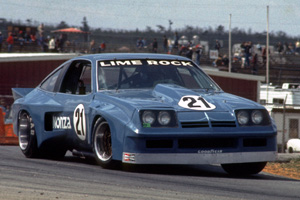
1975 Monza Dekon (c/n 1002) Harry
Theodoracopulos #21, was first owner. SCCA Trans-Am
Pocono Int'l Raceway - May 9, 1976
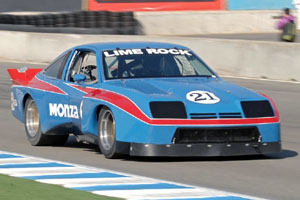
1975 Monza Dekon (c/n 1002) Harry Theodoracopulos' old car.
Chad Raynal #21 is current owner.
Monterey Historic Automobile Races at Laguna
Seca Raceway, CA - August 2009. |
The second DeKon Monza All-American GT (AA/GT) chassis built
was #1002. DeKon Engineering built this vehicle for Harry
Theodoracopulos. "Harry T" ended up wrecking the
vehicle during his first practice session and sent the car
back to Dekon, where it was repaired and updated. One
of the updates the car got was an extra bar, running from
the main roll hoop, and down to the passenger foot well
area. They named this extra bar the 'Harry bar,' because
they were worried he'd need the extra bracing for his next
big wreck.
In 1975 and 1976, Harry T, ran his car (c/n 1002) in IMSA GT
events at Lime Rock, Sebring and Road Atlanta. He also
entered the car in both the Watkins Glen and Pocono SCCA
Trans-Am events in 1976.
In 1978, William Wonder purchased and raced the car in IMSA.
It remained in William Wonder's possession until the late
1980s and has since been vintage raced.
|
Specifications 1975 Series
|
Tuner |
DeKon Engineering
LTD |
|
Chassis Number |
1002 |
|
Engine Location |
Front |
|
Drive Type |
Rear Wheel |
|
Production Years
series |
1975 - 1980 |
|
Weight |
2,400 lbs (1088.6 kg) |
|
Engine Configuration |
V-8 |
|
Displacement |
4927.00 cc | 300.7 cu in. |
|
Fuel Feed |
Fuel Injected |
|
Aspiration/Induction |
Normal |
|
Horsepower |
650.00 HP (478.4 KW) |
|
Torque |
556.00 Ft-Lbs (753.9 NM) |
|
HP / Liter |
132.7 BHP / Liter |
|
Transmission |
Manual |
|
Gears |
4 |
|
|
|
|
|
|
|
|
|
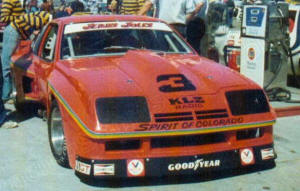
1976 DeKon-Monza (c/n 1007) Phase-3, Jerry
Jolly #3 "Spirit of Colorado/KLZ Radio" during Shasta
Monterey Grand Prix at Laguna Seca 100 - October 3, 1976
Gerry Wellik became the second owner.
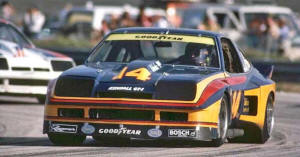
Tale of two Monzas, driver Al Holbert
#14 DeKon (c/n 1008) Phase-3, chased by Michael Keyser
#1 DeKon (c/n 1003). Here, Keyser won the IMSA Daytona
Finale 250 on Nov. 28, 1976.
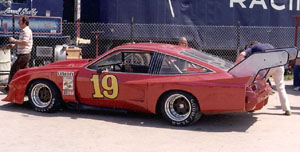
1976 DeKon-Monza (c/n 1011) Phase-5, driver
Chris Cord #19 at
IMSA Camel GT/World Sports Car Championship, a 6 hour
endurance race at Riverside Int'l Raceway, CA on April 26,
1981 |
This 1976 Dekon Monza, red #107 (c/n 1007) is
thought to be one of the most original Dekon Monzas in this
country. It was driven by Jerry Jolly in the IMSA Camel GT
Circuit in 1976, 1977 and 1978.
It was later owned and raced in the SCCA
Trans Am series by Gerry Wellik and Jerry Hansen from about
1979 through about 1982. The car was placed in storage for
20 years and was found by the current owner in 2002. It is
currently vintage raced at events in southern California.
This car is powered by an eight-cylinder engine capable of
producing 600 horsepower and 550 foot-pounds of torque.
|
Specifications 1976 Series
|
Tuner |
DeKon Engineering
LTD |
|
Chassis Number |
1007 |
|
Engine Location |
Front |
|
Drive Type |
Rear Wheel |
|
Production Years
series |
1975 - 1980 |
|
Engine Configuration |
V-8 |
|
Displacement |
5750.00 cc | 350.9
cu in. |
|
Fuel Feed |
Fuel Injected |
|
Aspiration/Induction |
Normal |
|
Horsepower |
600 BHP @ 7200.00
RPM |
|
Torque |
550.00 Ft-Lbs (745.8
NM) |
|
HP / Liter |
103.4 BHP / Liter |
|
Transmission |
Manual |
|
Gears |
4 |
|
For 1976, a new engine supplier was
found and several new chassis had been
built and sold to different teams. It
seemed that it would be the perfect year
to demonstrate the Dekon cars real
potential.
Al Holbert had
taken delivery of his new car and
Michael Keyser had
purchased one. They won seven of the
fifteen races they entered and Al
Holbert won the 1976 title. In 1977, he
would do it again facing a stronger
opposition.
Porsche was allowed to run its 934s and
BMW had entered a fantastic 320 Turbo in
the capable hands of
David Hobbs that
proved fast, if not always reliable.
Al Holbert had
developed his car, now displaying a big
rear "banana" wing and the car proved
even more effective. Unfortunately, it
was to be the last IMSA title for a
Dekon Monza, as in
1978, the rules would allow Porsche
935s, cars that would dominate the
series for a while. Monzas would still
be seen on the Camel GT circuit, but
would never win a race anymore.
Chris Cord's 1980 season body work would
be the most radically styled "PHASE"
seen. He took a Phase 5 body, then cut
large slotted openings on either side of
the long 3" hood tunnel/bulge to serve
as exits for the radiator-cooled air.
This diverted heat away from the engine
and helped to create a "suction" effect
under the car for better handling. The
hood tunnel was very tall to clear the
four down-draft carbs. The rear of the
hood matched the angle of the sloped
windshield, and sat just a few inches
from it. The door extensions had large
scoops for side mounted oil coolers.
Each rear fender had a large slotted
opening on top to serve as an exit for
the side-mounted radiator-cooled air.
Rear wheels were 19" tall, the largest
ever seen on a Monza.
|
|
|
|
|
|
|
|
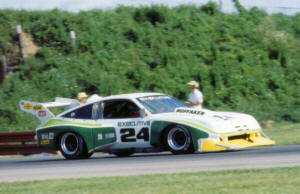
DeKon-Monza (c/n 1004) Phase-5, driver
Tom Frank #24, finished 4th at Mid-Ohio -June 5,
1977. Car with updated 'cow catcher' front air dam.
(Again, 30 years previous to same chassis above.)
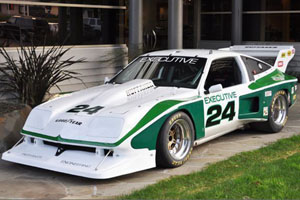
DeKon-Monza (c/n 1004) Phase-5, formerly
owned by Tom Frank. Now owned and vintage raced in Colorado. |
This was the last year DeKon Engineering Ltd.
produced the Monza GT racer. The most identifiable
feature in '77 was a redesigned front air dam, referred to
as a "cow catcher", with vertical strut bracing. The
cars were becoming technically dated and outperformed by
newer Trans-Am and IMSA GT entrants.
Tom Frank drove c/n 1004 from 1976 through
1979 at such events as the Road Atlanta 100 "WQXI Camel GT"
IMSA race on April 17, 1977. He was 5th on the grid,
finishing in the same position that day. The sponsor
for the white/green #24 Monza was "Executive/Huffaker."
|
Specifications 1977 Series
|
Tuner |
DeKon Engineering
LTD |
|
Chassis Number |
1004 |
|
Engine Location |
Front |
|
Drive Type |
Rear Wheel |
|
Production Years
series |
1975 - 1980 |
|
Engine Configuration |
V-8 |
|
Displacement |
5750.00 cc | 350.9
cu in. |
|
Fuel Feed |
Kinsler Fuel
Injection |
|
Aspiration/Induction |
Normal |
|
Horsepower |
600 BHP @ 7200.00
RPM |
|
Torque |
550.00 Ft-Lbs (745.8
NM) |
|
HP / Liter |
103.4 BHP / Liter |
|
Transmission |
Manual |
|
Gears |
4 |
|
|
|
|
|
| |
Road Racing Organizations
|
| |
| |
|
International Motor Sports
Association (IMSA) |
|
|
|
|
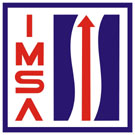
Official IMSA logo
|
 |
|
GTO |
|
|
|
 |
|
GTU |
IMSA GT
Groups
|
|
The International Motor Sports
Association (IMSA) is an American road racing
organization and sanctioning body based in
Braselton, Georgia. It was started by John
Bishop, a formerly of SCCA, and his wife Peggy
in 1969 with help from Bill France, Sr. of
NASCAR. Camel cigarettes was the title
sponsor for the IMSA racing series known as,
"Camel GT Challenge Series," from about 1975
-1984.
|
|
Glossary
of Abbreviations
|
AAGT
|
All American
Grand Touring - IMSA class
|
|
ASSC
|
Australian
Sports Sedan Championship |
|
CAT.I |
Category 1,
SCCA Trans-Am class |
|
CAT.II |
Category 2,
SCCA Trans-Am class |
|
c/n |
Chassis
number, or chassis name |
|
GT-1 |
Grand Touring
1 - SCCA Club Racing |
|
GTO |
Grand Touring
Over 2.5 Liters - IMSA class |
|
GTU
|
Grand Touring
Under 2.5 Liters - IMSA
class |
|
IMSA |
International
Motor Sports Association |
|
HSR |
Historic
Sportscar Racing |
|
SCCA |
Sports Car
Club of America |
|
TA |
Trans-Am,
SCCA pro series |
|
|
|
|
|
Title sponsors for IMSA GT
series |
|
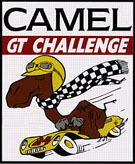 |
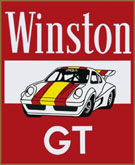 |

 |

 |

 |
|
IMSA Camel GT Challenge
Original logo 1972 - 1978
|
IMSA Winston GT
1979 only |
IMSA Winston GT
1979 (typical decals) |
IMSA GT Series
1980 only |
IMSA Camel GT Championship
1981 - 1993 |
|
|
|
|
|
|
|
|
 |
|
|
Sports Car Club of America |
|
|
|
|
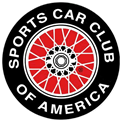
SCCA "wheel" |
|
|
|

Period SCCA decal 1970s-'80s |
|
The SCCA traces its roots to the Automobile
Racing Club of America (not to be confused with the current
stock car series of the same name). ARCA was founded in 1933
by brothers Miles and Sam Collier, and dissolved in 1941 at
the outbreak of World War II. The SCCA was formed in 1944,
at first as only an enthusiast group. The SCCA began
sanctioning road racing in 1948, with the inaugural Watkins
Glen Grand Prix. Cameron Argetsinger, an SCCA member and
local enthusiast who would later become Director of Pro
Racing and Executive Director of the SCCA, helped organize
the event for the SCCA.
In 1951, the SCCA National Sports Car Championship was
formed from existing marquee events around the nation,
including Watkins Glen, Pebble Beach, and Elkhart Lake. Many
early SCCA events were held on disused air force bases,
organized with the help of Air Force General Curtis LeMay, a
renowned enthusiast of sports car racing. LeMay loaned out
facilities of Strategic Air Command bases for the SCCA's
use; the SCCA relied heavily on these venues during the
early and mid 1950s during the transition from street racing
to permanent circuits.
By 1962, the SCCA was tasked with managing the U.S. World
Sportscar Championship rounds at Daytona, Sebring,
Bridgehampton and Watkins Glen. The club was also involved
in the Formula 1 U.S. Grand Prix. SCCA Executive Director
John Bishop helped to create the United States Road Racing
Championship series for Group 7 sports cars to recover races
that had been taken by rival USAC Road Racing Championship.
Bishop was also instrumental in founding the SCCA Trans-Am
Series and the SCCA/CASC Can-Am series. In 1969, tension and
in-fighting over Pro Racing's autonomy caused Bishop to
resign and help form the International Motor Sports
Association (IMSA). |
|
|
|
|
|
SCCA Trans-Am
Professional Racing Series |
|
|
|
|

Official Trans-Am logo |
|
|
|

Period Trans-Am decal 1970s |
|
The Trans-Am Series is an automobile racing
series which was created in 1966 by Sports Car Club of
America (SCCA) President John Bishop. Originally known as
the Trans-American Sedan Championship it has evolved over
time from its original format as a manufacturers
championship for modified racing sedans to its current form
as a drivers championship open to GT style cars.
Rules changed over the years. Trans-Am became
a tube frame silhouette racing car class instead of
production-based. In 1976, Trans-Am returned to the two
category format, classifying FIA Group 4 and 5 cars as
"Category II" through 1979. The tube frame silhouette Monza
racer was part of "Cat II" as displayed on sided of cars.
Throughout the years, some of the greatest
names in motorsports have participated in the Trans-Am
Series. Multiple championships winners include Paul
Gentilozzi, Tommy Kendall, Mark Donohue, Scott Pruett, Wally
Dallenbach Jr., George Follmer, Peter Gregg, Horst Kwech,
Scott Sharp and Bob Tullius.
|
SCCA Trans-Am
Categories 1976-79 |
|
CATEGORY I
CATEGORY II
|
Cars prepared
to specifications for SCCA production and
sedan classes.
Cars prepared
to FIA Groups 1-5 specifications and
specially authorized cars. |
|
|
|
|
|
|
|
SCCA Club Racing
Amateur Racing Series |
|
|
|
|

SCCA Club Racing decal |
|
|
|
 |
|
The club racing program is the amateur road
racing division where drivers race on either dedicated race
tracks or on temporary street circuits. Competitors require
either a regional or a national racing license. Both
modified production cars (ranging from lightly modified cars
with only extra safety equipment to heavily modified cars
that retain only woops the basic shape of the original
vehicle) and designed-from-scratch "formula" and "sports
racer" cars can be used in club racing. Most of the
participants in the Club Racing program are unpaid amateurs,
but some go on to professional racing careers. The club is
also the source for race workers in all specialties.
The annual national championship for Club Racing is called
the SCCA National Championship Runoffs and has been held at
Riverside International Raceway (1964, 1966, 1968), Daytona
International Speedway (1965, 1967, 1969), Road Atlanta
(1970–1993), Mid-Ohio Sports Car Course (1994–2005), and
Heartland Park Topeka (2006–2008). Since 2009, the Runoffs
are held at Road America in Elkhart Lake, Wisconsin, for a
minimum of three years. The current SCCA record holder is
Jerry Hansen with 27 national titles.
Rule changes and technical obsolescence
spelled the end for the Monza as a viable race car in IMSA
GT championship and SCCA Trans-Am series. The
silhouette/tube frame racer car descended into the amateur
ranks of SCCA Club Racing's GT1 and AS (American
Sedan) classes.
Today,
the Chevrolet Monza racer has returned to historic/vintage
racing circuits on the east and west coasts. Once again, it
has proven itself as a crowd pleaser at vintage events such
as the Monterey Historic Automobile Races at Mazda
Raceway Laguna Seca in southern California. |
|
|
|
|
|
|
|
SCCA Trans-Am Series and Sponsor
Logos
Typical decals and sponsors from this
period |
|
|
|
|
|
 |
 |
 |
|
SCCA Trans-Am series 1980-82 |
SCCA Trans-Am series 1983-84 |
SCCA Trans-Am series 1985-87 |
|
|
|
|
|
Historic Motor Sports Association |
|

Restoration, Preservation & Use |
|

|
|
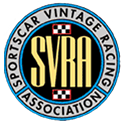 |
|
The Historic Motor Sports Association is one of the most
respected historic racing organizations in the United
States, producing world class spectator events across the
country in addition to managing one of the largest high net
worth member-based associations. HMSA events feature
historic production cars built through 1966 and purpose
built Formula and Sports Racing cars built through 1984.
HMSA members own, restore, preserve and race the most
historic and valuable sports and racing cars in the world.
HMSA was created in 1977 to serve as a sanctioning body for
premiere historic racing events in North America. It is the
only organization in the United States that requires the
cars to be historically correct based on the period of time
that the car originally raced.
Historic Sportscar Racing
Historic Sportscar Racing is one of few other vintage racing
clubs. Historic racing series such as HSR represent
the fastest growing segment of motorsports in the United
States and Europe. Fans flock to see historic racecars
compete as they did on road racing circuits decades ago.
Sportscar Vintage Racing
Association
The Sportscar Vintage Racing Association was
founded over 20 years ago with the vision of keeping vintage
race cars on race tracks where they belong, delighting fans
just as they did in their heyday. |
|
|
|
|
|
![]()
![]()